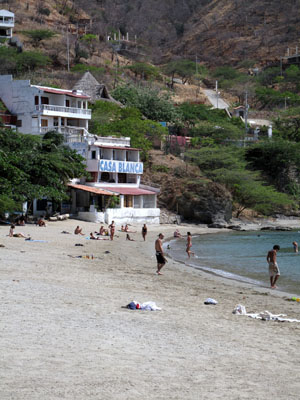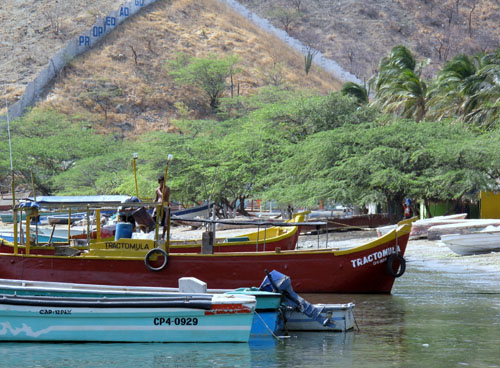Taganga, Colombia
Taganga is a fishing village close to the maritime port of Santa Marta and closer yet to the national park called Parque Tayrona, the lost city (la Ciudad Perdida), and some of the high peaks of the Sierra Nevada (seldom seen due to cloud cover). Taganga itself has two PADI diving centers and easy transportation by boat (or a hot dusty walk) to la Playa Grande, the large beach where covered beach chairs can be rented and fresh food enjoyed at the numerous cafes.

Taganga, Colombia
The butterflies and birds are numerous and the sunsets are fabulous. But what an unlikely place for a bustling tourist trade! Taganga does not even have its own fresh water supply; it is brought in by water trucks and pumped to tanks on the tops of homes and businesses. But what it does have is a local populace who are friendly, helpful, and capable. And patient enough to correct bad Spanish and to learn a few more words of English. Plus the area is “laid back” enough to be relaxing.
It is close enough to Cartagena that the bus ride is tolerable yet small enough to give the feeling of “getting away” to the countryside. Not a shopping mecca by any means, there are plenty of gift items to purchase from the numerous vendors.
Food is good, with local foods plus European varieties easy to find. It is likely that a tourist could easily spend a week there without ever knowing he or she was offered tourist cooking. Example: We had read about arepas, the Colombian version of an empanada more or less, but we had never seen them on a menu. At a local café one morning, I watched a local resident bite into what looked like a tortilla sandwich and pour hot sauce into the steamy bite.
I told the waiter I would take one and pointed at it. Fabulous choice! I watched the cook take two corn tortilla, sealed together the edges, drop a raw egg in the middle, then deep fry it. Not at all greasy, the hot sauce gave a delightful flavor to the now-cooked egg.
The dive shops were very popular early in the morning as they set up to take clients out for the day. Their reputations were good and we were told by happy customers that the operation was top notch, professional, and yet friendly.

Fishing boats Taganga, Colombia
One bit of warning: Although the fishing boats were fine for traveling from Taganga’s harbor to Playa Grande, we heard quite a few horror stories from travelers who had taken them to Parque Tayrona. The waves can be high, the landings difficult, and the life jackets we saw and used were not the oceangoing variety. Check carefully before committing to that adventure!
The transport of passengers to Playa Grande is very well organized and appears to have two price structures: one for locals and one for tourists. We never managed to “score” the local prices no matter how we bartered… Again, though, it is local “know how” at its best. Each boat captain not only knew his passengers by site, he seemed to know who belonged to other boats.
Our evidence for this is that one morning we asked our boat to return for us at 2 PM. It was 2:30 and we still had not seen the boat so we asked a different boat captain whether we could catch a ride back. He gave us a perplexed look and asked why we did not want to ride back in the boat we had come in on; he pointed it out up the beach, pretty well hidden by a larger boat. Even though he undoubtedly would have liked to have returned for more fares, our captain had waited for us! We apologized for making him wait and gave a good tip.
Be sure to read our other posts on Taganga, La Casa de Felipe, and Baguettes in Taganga.

Susnset Taganga, Colombia


Comments
Taganga, Colombia — No Comments
HTML tags allowed in your comment: <a href="" title=""> <abbr title=""> <acronym title=""> <b> <blockquote cite=""> <cite> <code> <del datetime=""> <em> <i> <q cite=""> <s> <strike> <strong>